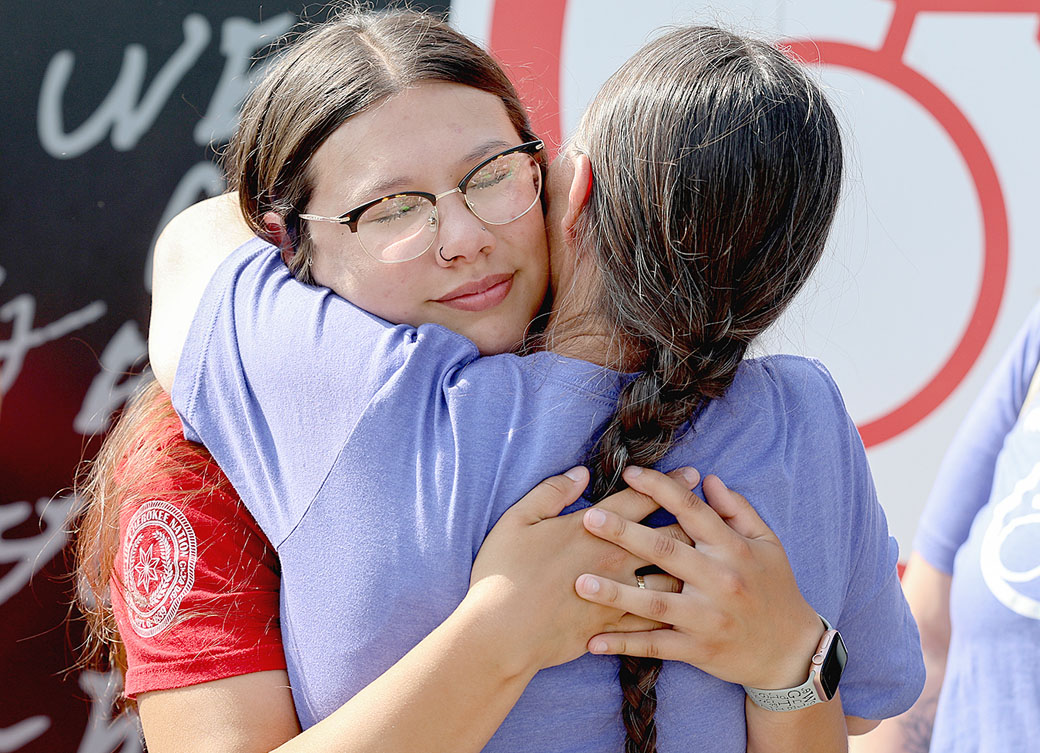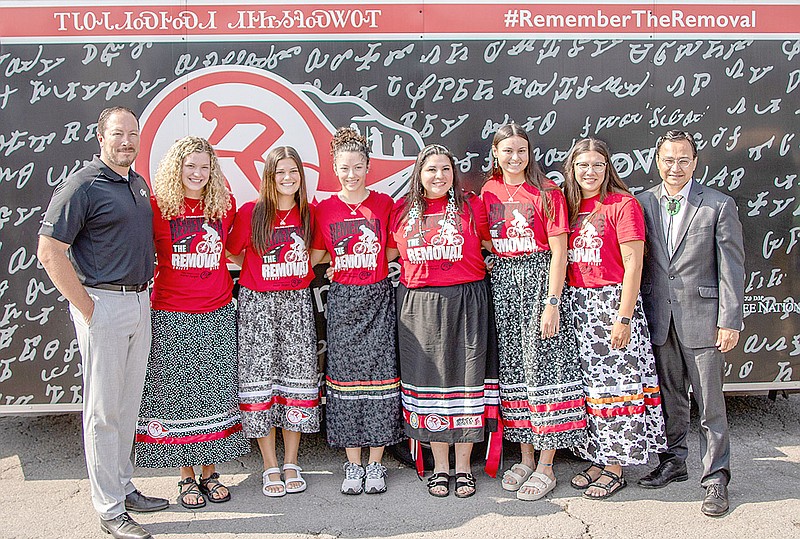TAHLEQUAH, Okla. -- Imprinted within the minds of Cherokee women rises an image of Nanyehi, known as Nancy Ward, picking up her dead husband's rifle and leading Cherokee warriors to victory.
That's a significant piece of Cherokee history to recall as six Cherokee Nation "Remember the Removal Bike Ride" participants left for Cherokee, N.C. on Wednesday, May 31, following a send-off ceremony at the Cherokee Nation W.W. Keeler Tribal Complex, marking the second consecutive year for the team to be comprised entirely of Cherokee women.
Throughout the ages, Cherokee women have embraced the role of taking a stand.
Nanyehi would become a great peace advocate as the Most Beloved Woman of the Cherokee but her path to prominence didn't begin that way.
Leaders Emerge In 1755
Kingfisher, her husband and father of their two children, was dead.
Nanyehi hardly seemed to give that a thought as the Battle of Taliwa raged around her in 1755. There was an enemy to deal with and Nanyehi led by example, stepping into the role of a warrior as Kingfisher's spirit separated from his lifeless body.
He couldn't help her now, but what mattered at that moment to this daughter of the Wolf Clan meant vanquishing the Creeks.
She was not alone. Cherokee war chief Oconostota led 500 warriors and engaged a larger force of Creeks. According to the Georgia Historical Society, the Creeks' defeat near the confluence of Long Swamp Creek and the Etowah River, approximately 50 miles due north of Atlanta, was so complete that the Creeks retreated south of the Chattahoochee River, relinquishing the area.
The United States hadn't been birthed into existence yet, but on July 9 of the same year, 23-year-old Colonel George Washington, who would become known as the "Father of our country," found himself fully engaged in "The Battle of Monongahela" approximately 640 miles to the northeast. Washington served as aide-de-camp to British General Edward Braddock when they were ambushed by the French and their Indian allies in 1755 seven miles south of Fort Duquesene, now present day, Pittsburgh, Penn.
Fifteen years later Washington and a close personal friend, Dr. James Craik, returned to view the battleground and were met by an old Indian chief, who stated, "I have traveled a long and weary path that I might see the young warrior of the great battle ... I am come to pay homage to the man who is the particular favorite of Heaven, and who can never die in battle."
This chief told Washington he instructed his braves to pick off the officers and they had targeted Washington. The chief said he personally fired 17 shots at Washington, but without effect. Convinced Washington was being supernaturally protected, he told his warriors to cease firing at Washington.
Washington had found four bullet holes in his coat and several horses were shot out from under him during the battle. The next day he wrote a letter to his family, contradicting rumors of his death, writing, "By the all powerful dispensations of Providence, I have been protected beyond all human probability or expectation."
History records these events in 1755, as a pivotal year in forming future leaders who would shape the destiny of the United States.
Retracing Trail Of Tears
For Nanyehi, her impact was just beginning.
Her transformation from warrior to peace advocate is well documented, and serves as an example for 2023 Cherokee Nation cyclists, Faith Springwater, 19, of Tahlequah, Okla., Amaiya Bearpaw, 22, of Jay, Okla., Mattie Berry, 18, of Warner, Okla., Kenzie Snell, 19, of Park Hill, Okla., Samantha Cavin, 18, of Pryor, Okla., and mentor cyclist Libby Neugin, 40, of Tulsa, Okla., as they embark upon an approximately 950-mile bike ride retracing the northern route of the Trail of Tears, beginning in New Echota, Georgia, the former capital of the Cherokee Nation, and ending on June 17 in Tahlequah, Okla..
The northern route of the Trail of Tears crosses seven states, Georgia, Tennessee, Kentucky, Illinois, Missouri, Arkansas and Oklahoma. The cyclists joined five participants from the Eastern Band of the Cherokee Indians in North Carolina to train before their ride officially began on Monday, June 5.
Principal Chief Chuck Hoskin Jr. depicted the "Remember the Removal Bike Ride" as an annual reminder of the history of Cherokee ancestors who endured some of the worst tragedy in the history of the Cherokee Nation.
"The bike ride also opens such a tremendous opportunity for several Cherokees each year to learn that history and honor the legacy of their ancestors. While accomplishing a life-changing journey across seven states, these six Cherokees will also reflect on how the Cherokee people persevered during the Trail of Tears and in the decades that followed. They are going to lead us in the weeks ahead and in the years to come, and I couldn't be prouder of each of them," Chief Hoskin said.
Connecting Family Trees
As part of their experience, each cyclist examined their family trees through mapping done by a professional genealogist, creating another avenue through which they might gain perspective into their ancestral lines and potentially connect dots with each other's ancestries.
"This opportunity means a lot to me, and I'm just humbled and thankful," Springwater said. "I'm eager to soak in as much of the experience as I can, and I hope to learn much more about my heritage. I think the thing I'm looking forward to the most is just being with my team experiencing the trials and tribulations that our ancestors faced."
The bike ride takes cyclists to several Cherokee grave sites and historic landmarks, including Blythe Ferry in Tennessee at the westernmost boundary of the old Cherokee Nation, and Mantle Rock in Kentucky, where Cherokees spent several weeks during the harsh winter of 1838-1839 waiting for the Ohio River to thaw and become passable.
Snell decided to be a part of this year's bike ride because she wanted to be involved in her Cherokee heritage, and become one of those role models she looked up to as a child.
"I always knew about the bike ride growing up and I always looked up to the cyclists. I even have family that are alumni. So I've always wanted to join that prestigious group because I think it's a pretty amazing thing to do," Snell said.
A Cherokee Nation press release denoting the ride states, "Of the estimated 16,000 Cherokees forced to march to Indian Territory in the late 1830s, about 4,000 died due to exposure, starvation and disease," giving credence to the name "Trail of Tears."
For more information on the Remember the Removal Bike Ride or to follow along during the journey, visit Facebook.com/removal.ride.
 Submitted photo/Amaiya Bearpaw, 22, of Jay, Okla., receives a hug as the Cherokee Nation celebrated the "Remember the Removal" bike riders on May 31, 2023, before sending them off to North Carolina where they will train with members of the Eastern Band of Cherokee before retracing approximately 950 miles along the northern route of the Trail of Tears, which spans seven states, including Georgia, Tennessee, Kentucky, Illinois, Missouri, Arkansas and Oklahoma.
Submitted photo/Amaiya Bearpaw, 22, of Jay, Okla., receives a hug as the Cherokee Nation celebrated the "Remember the Removal" bike riders on May 31, 2023, before sending them off to North Carolina where they will train with members of the Eastern Band of Cherokee before retracing approximately 950 miles along the northern route of the Trail of Tears, which spans seven states, including Georgia, Tennessee, Kentucky, Illinois, Missouri, Arkansas and Oklahoma. Submitted Photo/Kenzie Snell, 19, of Park Hill, Okla., poses as the Cherokee Nation celebrated her as one of six cyclists embarking on a "Remember the Removal" bike ride spanning approximately 950 miles along the northern route of the Trail of Tears, which goes through Georgia, Tennessee, Kentucky, Illinois, Missouri, Arkansas and Oklahoma.
Submitted Photo/Kenzie Snell, 19, of Park Hill, Okla., poses as the Cherokee Nation celebrated her as one of six cyclists embarking on a "Remember the Removal" bike ride spanning approximately 950 miles along the northern route of the Trail of Tears, which goes through Georgia, Tennessee, Kentucky, Illinois, Missouri, Arkansas and Oklahoma.
